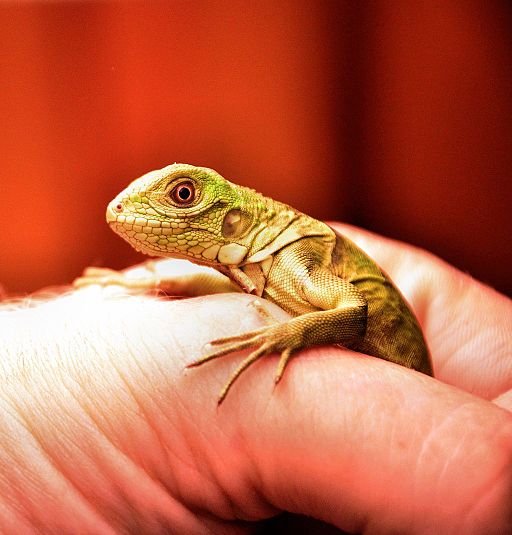To commemorate Iguana Awareness Day on September 8th, we’ve collected ten of the most interesting, funny, downright weird, and fascinating facts about iguanas for your pleasure. So put the kettle on and prepare to be amazed (or at least mildly interested) by these wonderful animals.
Interesting Iguana Facts
1. Iguanas can get rather big.
The longest iguana, the green iguana, can grow up to two meters (6 ft) long from nose to tail. However, the heaviest iguana is the blue iguana, which can weigh a hefty 15 kilograms (30 lbs). That’s enough to do some bicep curls with (though we don’t recommend working out with an iguana).
But they aren’t all so big. The smallest iguana, the spiny-tailed iguana, can be as small as 12 centimeters (5 in)) long, but usually grow up to around 1 meter (3 ft) long.
2. Iguanas can quickly lose a lot of their length.
Famously, some lizards can detach their tails when caught by a predator to escape. Iguana tails usually grow back after detachment, but not to the same size or shape, and are often darker in color than before.
Iguana owners have reported pet iguanas who have exhibited this same behavior, usually by accident as a result of being kept in a cage that’s too small. Tail-dropping may also happen when the iguana feels scared or threatened, this being a defense mechanism.
Witnessing this can be disconcerting, as the tail shakes and wiggles on the floor after detaching. (In the wild, this is to distract the predator.) However, you can quickly treat your iguana by stopping the bleeding and treating the wound.
3. Some iguanas are very fast!
The Black Spiny-Tailed iguana, native to Mexico and Central America, is capable of growing up to 1.3 meters (4 ft) and is recognized as the fastest-running species of lizard, with maximum sprint speeds of just under 35 kilometers (22 miles) an hour. Now that’s quick!
Amazingly, the Black Spiny-Tail is known to eat the fruit and live in the limbs of the Manchineel, which was named by the Guinness Book of World Records as the most dangerous tree alive due to its poisonous nature.
4. Iguanas don’t always run from a fight.
When cornered, iguanas may lash out to defend themselves. Iguanas have sharp teeth, sharp spines that run down their back, and powerful tails.
Iguanas use their tails as a defense mechanism and sometimes use them to whack predators away. Iguanas may also bite when cornered, so don’t pick a fight with an iguana!
5. Iguanas like it warm (Who doesn’t?!)
Like most of us, iguanas enjoy warmer temperatures. For this reason, they’re found predominantly in Central and South America, though they can also be found in the Galapagos Islands, Fiji, Madagascar, and the Caribbean. If you’re looking to spot one, head to tropical or subtropical forests, deserts or coastlines.
Due to an unintentional introduction, reportedly by people setting their pets loose, iguanas now run free in some parts of southern Florida, too! If you have a pet iguana, please make sure not to let it out, especially if you’re in rainy Britain.
6. Most iguanas are vegans.
Iguanas are herbivores, meaning they favor vegetation – flowers, fruits, and leaves, generally. Marine iguanas find food by scraping algae from rocks or by eating seaweed.
However, if the opportunity arises, iguanas will eat animals, eggs, and insectivores. Sadly these are not particularly healthy for them, and are generally on the ‘naughty but nice list”. A bit like chocolate and french fries for us!
7. Iguanas have a third eye.
That’s right – but not the kind of third eye conspiracy theorists talk about. On top of their heads, iguanas have what is called a parietal eye.
While this eye can’t make out details, it can differentiate between dark and light. The eye regulates the circadian rhythms, and it helps to produce hormones for thermoregulation – meaning it helps control the body temperature of the iguana even when the temperature of the surrounding environment is very different.
Many other animals have a third eye, including frogs, salamanders, and sharks. Mammals don’t have them, but one of our closest relatives, the therapsids, who are now extinct, did have them.
8. Iguanas are tough creatures.
While it may seem like iguanas are a bit delicate because their tails keep falling off, the reverse is true. These lizards have a higher relative biting force in comparison to other carnivorous and omnivorous reptiles, which helps them acquire and digest plant matter.
This biting force has been achieved through years of evolution by the strengthening and widening of the skull. As a result, the skull can withstand stronger forces.
The iguana’s stronger skull bone may explain why some iguanas can fall from great heights and survive relatively unscathed. The green iguana, for instance, has been observed falling from as high as 12 meters (40 ft) and surviving.

9. Iguanas lay eggs.
The amount of offspring a single iguana will produce varies among species. Iguanas, like most lizards, lay eggs. Some, like the Rock iguana, lay between 5 and 20 eggs at a time.
Eggs are burrowed away somewhere warm, and then the mother leaves. Baby iguanas are left to mature by themselves after they hatch, meaning many aren’t protected in the wild. The babies are often killed by predators before reaching maturity. Those that do live survive for around 20 years in the wild, though they generally die younger when in captivity.
Other species, like the Green Iguana, may produce up to 60 eggs, which makes one wonder how they could ever be at risk of extinction, based on sheer numbers alone.
RELATED:
Jamaican Iguana Thought to be Extinct Makes a Comeback
10. It’s not all good news.
According to the International Union for the Conservation of Nature, iguanas are among the most endangered animals in the world. In 2012, the population of the Pink Land iguana was counted, and less than 200 mature members of this species were found. Some other populations have dropped by 50% in the last thirty to forty years.
The Marine iguana is perhaps the most famously endangered iguana. These lizards predominantly nest on a tourist beach on Isabela Island. The World Wildlife Organisation managed to extend a protected area there to conserve the habitat of the iguana, but there’s still work to do.
Hopefully, we won’t see this magnificent creature go extinct in the coming years. For now, wildlife organizations are working their hardest to save this animal from destruction. Let’s hope they succeed!
~~~~~
“10 Fascinating Facts About Iguanas, Iguana Awareness Day 8 September”
Featured Image: Creative Commons, maxpixel.net
Guest Author: James Alston writing for ExoticDirect pet insurance.
*** Please Share ***
10 Fascinating Facts About Iguanas, Iguana Awareness Day 8 September #iguanaFacts #reptileFacts Share on X
![]()
MY QUESTION FOR YOU:
Do you have an iguana? What’s his or her name?
- Mindful Travel With Your Dog This Holiday Season - December 23, 2019
- A-Z of Australia’s Endangered Wildlife - December 20, 2019
- Teaching Your Kids How to Walk the Dog Safely - December 2, 2019


